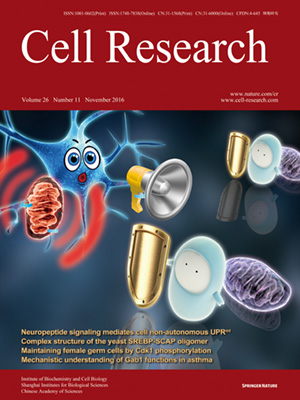
Volume 26, No 11, Nov 2016
ISSN: 1001-0602
EISSN: 1748-7838 2018
impact factor 17.848*
(Clarivate Analytics, 2019)
Volume 26 Issue 11, November 2016: 1212-1225 | Open Access
ORIGINAL ARTICLES
Inhibitory phosphorylation of Cdk1 mediates prolonged prophase I arrest in female germ cells and is essential for female reproductive lifespan
Deepak Adhikari1,4,*, Kiran Busayavalasa1,*, Jingjing Zhang1, Mengwen Hu1, Sanjiv Risal1, Mustafa Bilal Bayazit1, Meenakshi Singh1, M Kasim Diril2,5, Philipp Kaldis2,3 and Kui Liu1
1Department of Chemistry and Molecular Biology, University of Gothenburg, Gothenburg SE-405 30, Sweden
2Institute of Molecular and Cell Biology (IMCB), A*STAR (Agency for Science, Technology and Research), 61 Biopolis Drive, Proteos #3-09, Singapore 138673, Republic of Singapore
3Department of Biochemistry, National University of Singapore (NUS), Singapore 117597, Republic of Singapore
4Current address: Department of Anatomy and Developmental Biology, Monash Biomedicine Discovery Institute, Monash University, Melbourne, Victoria 3800, Australia
5Current address: Izmir Biomedicine and Genome Institute, Dokuz Eylul University, Izmir 35340, Turkey
Correspondence: Philipp Kaldis, E-mail: kaldis@imcb.a-star.edu.sg; Kui Liu,(kui.liu@gu.se)
A unique feature of female germ cell development in mammals is their remarkably long arrest at the prophase of meiosis I, which lasts up to 50 years in humans. Both dormant and growing oocytes are arrested at prophase I and completely lack the ability to resume meiosis. Here, we show that the prolonged meiotic arrest of female germ cells is largely achieved via the inhibitory phosphorylation of Cdk1 (cyclin-dependent kinase 1). In two mouse models where we have introduced mutant Cdk1T14AY15F which cannot be inhibited by phosphorylation (Cdk1AF) in small meiotically incompetent oocytes, the prophase I arrest is interrupted, leading to a premature loss of female germ cells. We show that in growing oocytes, Cdk1AF leads to premature resumption of meiosis with condensed chromosomes and germinal vesicle breakdown followed by oocyte death, whereas in dormant oocytes, Cdk1AF leads to oocyte death directly, and both situations damage the ovarian reserve that maintains the female reproductive lifespan, which should be around 1 year in mice. Furthermore, interruption of the inhibitory phosphorylation of Cdk1 results in DNA damage, which is accompanied by induction of the Chk2 (checkpoint kinase 2)-p53/p63-dependent cell death pathway, which eventually causes global oocyte death. Together, our data demonstrate that the phosphorylation-mediated suppression of Cdk1 activity is one of the crucial factors that maintain the lengthy prophase arrest in mammalian female germ cells, which is essential for preserving the germ cell pool and reproductive lifespan in female mammals.
10.1038/cr.2016.119
FULL TEXT | PDF
Browse 1960


